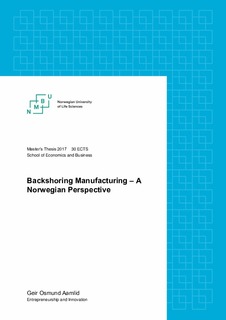| dc.description.abstract | Reallocation of manufacturing to Norway has become increasingly common in the past 3 years. This study has attempted to investigate the core motives behind the backshoring decision and which factors that account for a successful reallocation. In addition, study the potential of this phenomenon in Norway, both on a micro and macro level. This is done through case studies on Neuman Aluminium Raufoss, Hunton Fiber AS and Kleven Verft AS.
The study needs further quantified research, but it suggests that smart use of automation, the shortening of lead times and smart configuration of the supply chain are the main motives for backshoring. Furthermore, the research suggest that manufacturing firms do not backshore due to a failure to realize unexpected or hidden transaction costs, but because manufacturing technology is changing, allowing for new opportunities. It allows firms to quickly respond to dynamic markets, the operational flexibility of the firm, through a vertically integrated supply chain.
Furthermore, backshoring manufacturing require competence that may go beyond core competencies, to build and operate an automated manufacturing facility. Backshoring manufacturing companies are acquiring technological innovations to achieve their goal. Some have little experience with building a modern factory of industry 4.0, and are confronted with technical challenges and logistical iterations. However, the know-how is available to companies through open-R&D. This concept is widely used in Norwegian industrial clusters, establishing research institutions that share knowledge and collaborate with firms throughout the country.
The study differentiate itself from other research on backshoring, by focusing on non-strategic resources and automation, specifically the concept of industry 4.0. The ability for Norway to widen its industrial structure will be heavily dependent on infrastructure such as telecommunications, data centres, energy and transportation. In addition to an education system that is focused on digital competence. These factors will have an impact on to what degree Norway can operate as an attractive location for industry and a hub for international trade. This paper suggest that Norway handles these factors well, but the demand for infrastructure will increase with industry 4.0. | nb_NO |

